Application of Operant Theory in Class 8: A Case Study
VerifiedAdded on 2019/11/12
|9
|2455
|164
Essay
AI Summary
This essay examines the application of operant conditioning, a learning process controlled by consequences, within a Class 8 classroom setting. It explores the core concepts of operant conditioning, including positive and negative reinforcement, and positive and negative punishment, and their impact on student behavior. The essay analyzes typical behaviors of this age group, such as the need for independence and peer acceptance, and how these behaviors can be addressed using operant conditioning techniques. It provides practical examples of how teachers can use positive reinforcement (e.g., praising correct answers), negative reinforcement (e.g., reducing coursework for good performance), and punishment (e.g., detention) to enhance student participation, manage behavior, and create a conducive learning environment. The strengths and weaknesses of operant conditioning are discussed, highlighting its effectiveness in motivation and ease of administration, while also acknowledging its limitations in addressing complex behaviors and potential for temporary effects. The essay concludes by emphasizing the utility of operant theory as a tool for modifying student behavior and improving classroom dynamics.
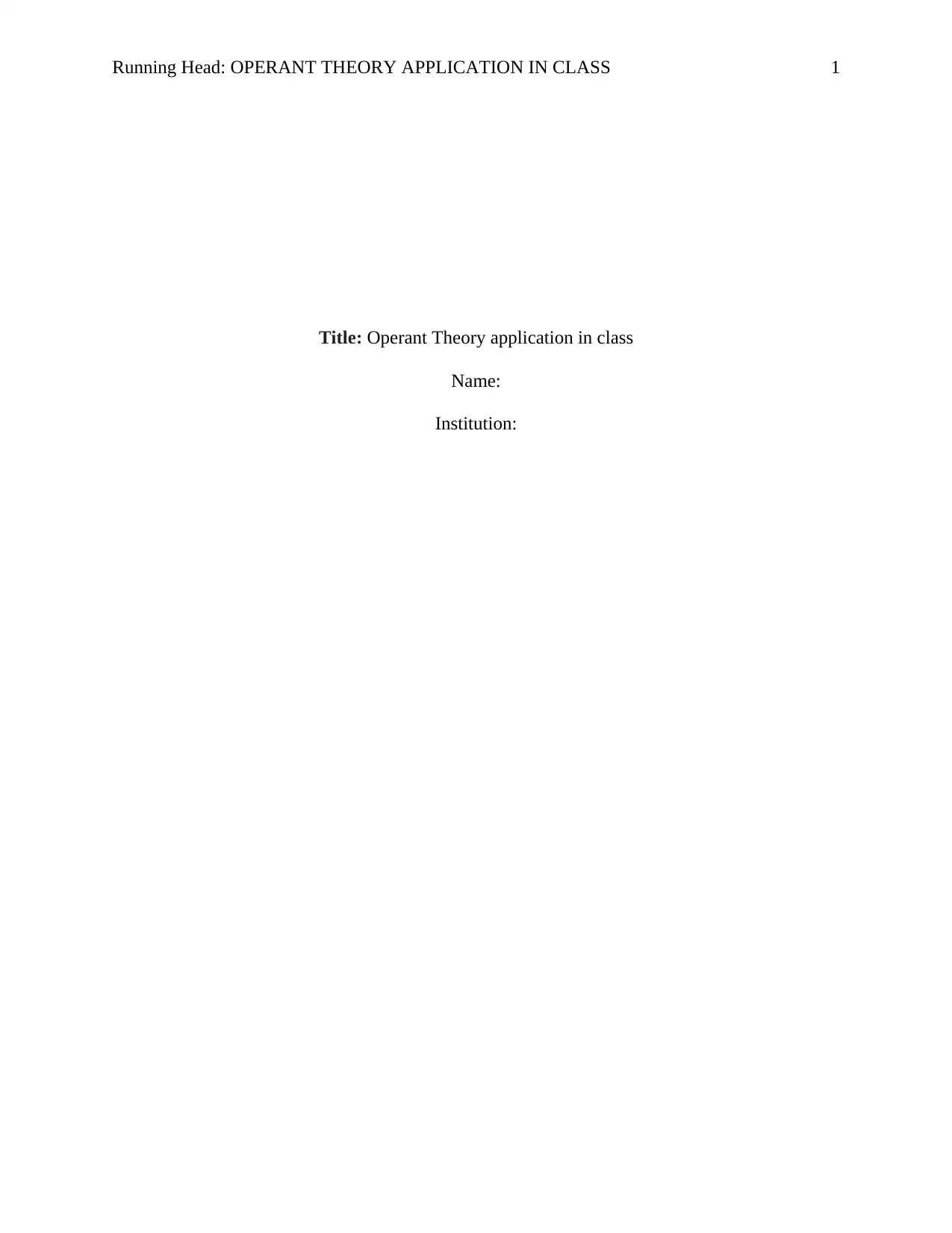
Running Head: OPERANT THEORY APPLICATION IN CLASS 1
Title: Operant Theory application in class
Name:
Institution:
Title: Operant Theory application in class
Name:
Institution:
Paraphrase This Document
Need a fresh take? Get an instant paraphrase of this document with our AI Paraphraser

OPERANT THEORY APPLICATION IN CLASS 2
Introduction
Operant conditioning is a learning process in which behaviour is controlled by
consequences. The process uses four key concepts, which are positive and negative
reinforcement, as well as positive and negative punishment. Through these, a teacher can be able
to create the conditions conducive for learning. At the same time, the teacher is able to identify
the conditions under which the students will be most responsive to the learning process (Henton
& Iversen, 2012).
Operant conditioning involves three concepts – punishers, reinforcers and neutral
operants. Regardless of their absence or presence, the subject does not alter their behaviour.
Reinforcers are referred to as responses from the environment which increases the likelihood of a
behaviour being repeated. Reinforcers can be negative or positive. On the other hand, punishers
are those responses whose occurrence decreases the probability of a behaviour recurring.
Punishers are meant to weaken the specific behaviour being targeted.
Positive reinforcement means that positive behaviour is rewarded with something
positive. For instance, a teacher may try to compliment students who give the right answers in
class by asking other to clap for them or complimenting them. The teacher may also organize
kinds of presents for student behaviour that could be encouraged, such as participation,
punctuality among others. Negative reinforcement on the other hand means that negative
behaviour attracts a derivation of something desirable. For instance, students can be asked to
hand in their assignment early, to avoid receiving a Fail grade in their coursework. Similarly, the
teacher may consider not using long hours to cover coursework if students pass a special test
which gauges their understanding of coursework (Coon & Mitterer, 2010).
Introduction
Operant conditioning is a learning process in which behaviour is controlled by
consequences. The process uses four key concepts, which are positive and negative
reinforcement, as well as positive and negative punishment. Through these, a teacher can be able
to create the conditions conducive for learning. At the same time, the teacher is able to identify
the conditions under which the students will be most responsive to the learning process (Henton
& Iversen, 2012).
Operant conditioning involves three concepts – punishers, reinforcers and neutral
operants. Regardless of their absence or presence, the subject does not alter their behaviour.
Reinforcers are referred to as responses from the environment which increases the likelihood of a
behaviour being repeated. Reinforcers can be negative or positive. On the other hand, punishers
are those responses whose occurrence decreases the probability of a behaviour recurring.
Punishers are meant to weaken the specific behaviour being targeted.
Positive reinforcement means that positive behaviour is rewarded with something
positive. For instance, a teacher may try to compliment students who give the right answers in
class by asking other to clap for them or complimenting them. The teacher may also organize
kinds of presents for student behaviour that could be encouraged, such as participation,
punctuality among others. Negative reinforcement on the other hand means that negative
behaviour attracts a derivation of something desirable. For instance, students can be asked to
hand in their assignment early, to avoid receiving a Fail grade in their coursework. Similarly, the
teacher may consider not using long hours to cover coursework if students pass a special test
which gauges their understanding of coursework (Coon & Mitterer, 2010).
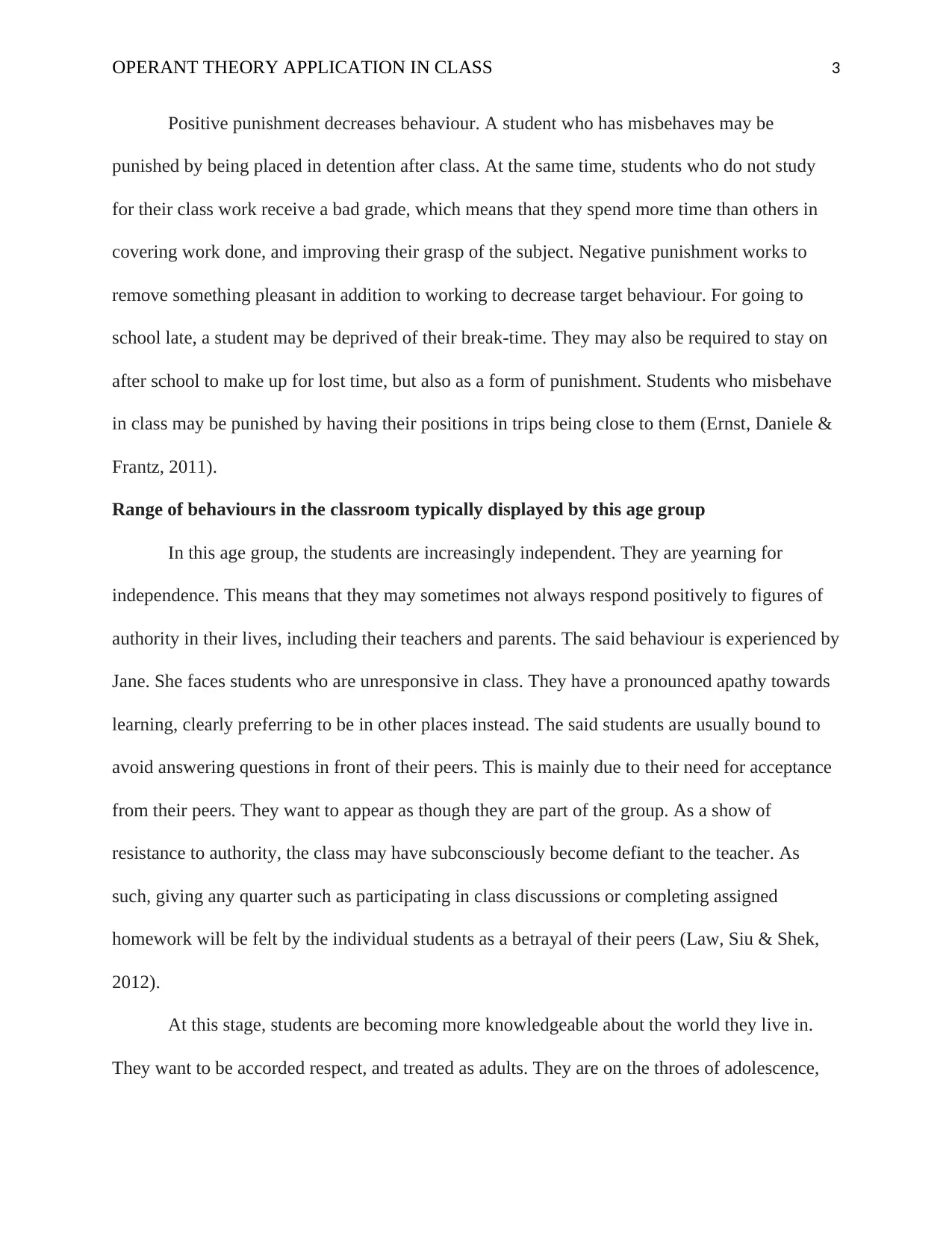
OPERANT THEORY APPLICATION IN CLASS 3
Positive punishment decreases behaviour. A student who has misbehaves may be
punished by being placed in detention after class. At the same time, students who do not study
for their class work receive a bad grade, which means that they spend more time than others in
covering work done, and improving their grasp of the subject. Negative punishment works to
remove something pleasant in addition to working to decrease target behaviour. For going to
school late, a student may be deprived of their break-time. They may also be required to stay on
after school to make up for lost time, but also as a form of punishment. Students who misbehave
in class may be punished by having their positions in trips being close to them (Ernst, Daniele &
Frantz, 2011).
Range of behaviours in the classroom typically displayed by this age group
In this age group, the students are increasingly independent. They are yearning for
independence. This means that they may sometimes not always respond positively to figures of
authority in their lives, including their teachers and parents. The said behaviour is experienced by
Jane. She faces students who are unresponsive in class. They have a pronounced apathy towards
learning, clearly preferring to be in other places instead. The said students are usually bound to
avoid answering questions in front of their peers. This is mainly due to their need for acceptance
from their peers. They want to appear as though they are part of the group. As a show of
resistance to authority, the class may have subconsciously become defiant to the teacher. As
such, giving any quarter such as participating in class discussions or completing assigned
homework will be felt by the individual students as a betrayal of their peers (Law, Siu & Shek,
2012).
At this stage, students are becoming more knowledgeable about the world they live in.
They want to be accorded respect, and treated as adults. They are on the throes of adolescence,
Positive punishment decreases behaviour. A student who has misbehaves may be
punished by being placed in detention after class. At the same time, students who do not study
for their class work receive a bad grade, which means that they spend more time than others in
covering work done, and improving their grasp of the subject. Negative punishment works to
remove something pleasant in addition to working to decrease target behaviour. For going to
school late, a student may be deprived of their break-time. They may also be required to stay on
after school to make up for lost time, but also as a form of punishment. Students who misbehave
in class may be punished by having their positions in trips being close to them (Ernst, Daniele &
Frantz, 2011).
Range of behaviours in the classroom typically displayed by this age group
In this age group, the students are increasingly independent. They are yearning for
independence. This means that they may sometimes not always respond positively to figures of
authority in their lives, including their teachers and parents. The said behaviour is experienced by
Jane. She faces students who are unresponsive in class. They have a pronounced apathy towards
learning, clearly preferring to be in other places instead. The said students are usually bound to
avoid answering questions in front of their peers. This is mainly due to their need for acceptance
from their peers. They want to appear as though they are part of the group. As a show of
resistance to authority, the class may have subconsciously become defiant to the teacher. As
such, giving any quarter such as participating in class discussions or completing assigned
homework will be felt by the individual students as a betrayal of their peers (Law, Siu & Shek,
2012).
At this stage, students are becoming more knowledgeable about the world they live in.
They want to be accorded respect, and treated as adults. They are on the throes of adolescence,
⊘ This is a preview!⊘
Do you want full access?
Subscribe today to unlock all pages.

Trusted by 1+ million students worldwide
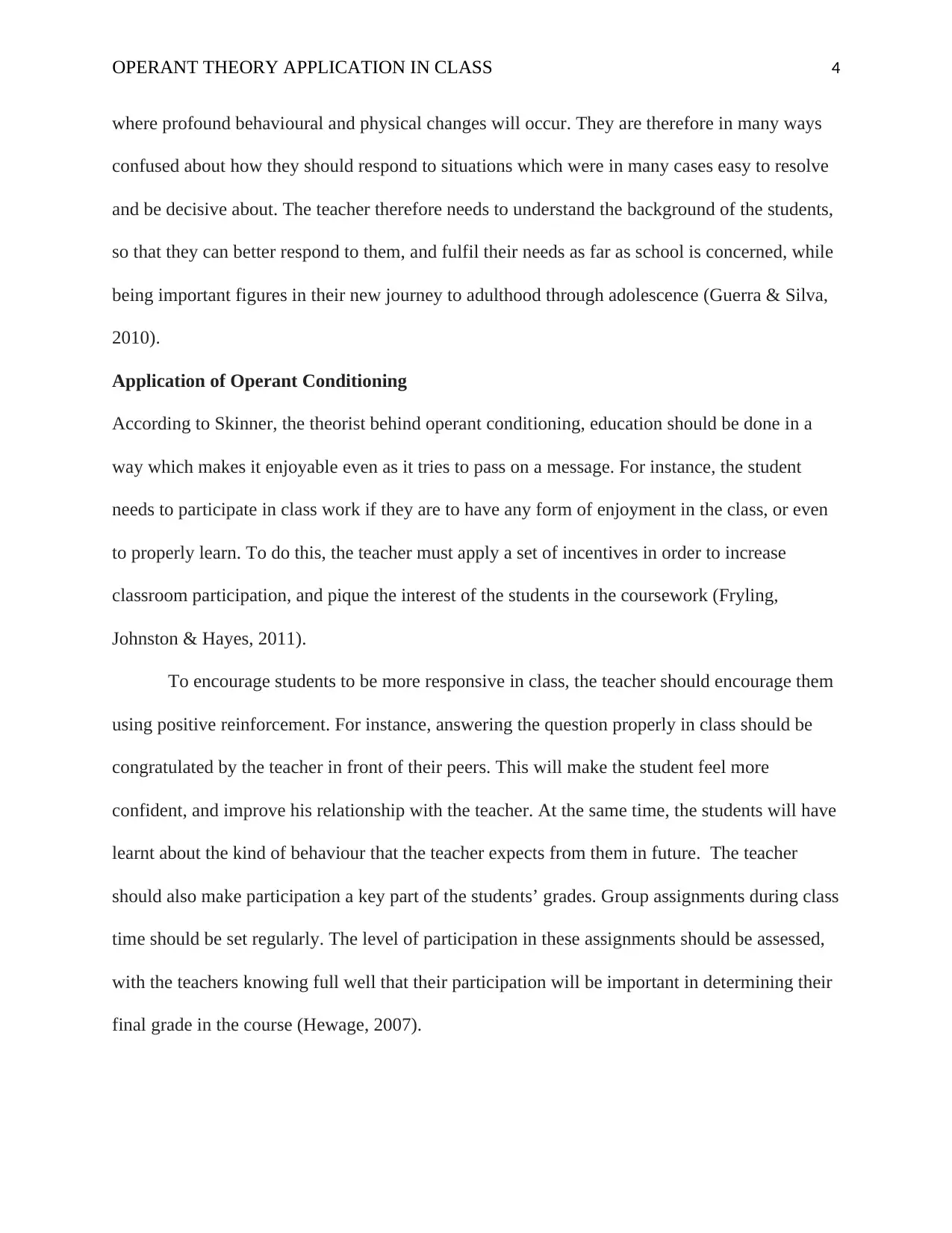
OPERANT THEORY APPLICATION IN CLASS 4
where profound behavioural and physical changes will occur. They are therefore in many ways
confused about how they should respond to situations which were in many cases easy to resolve
and be decisive about. The teacher therefore needs to understand the background of the students,
so that they can better respond to them, and fulfil their needs as far as school is concerned, while
being important figures in their new journey to adulthood through adolescence (Guerra & Silva,
2010).
Application of Operant Conditioning
According to Skinner, the theorist behind operant conditioning, education should be done in a
way which makes it enjoyable even as it tries to pass on a message. For instance, the student
needs to participate in class work if they are to have any form of enjoyment in the class, or even
to properly learn. To do this, the teacher must apply a set of incentives in order to increase
classroom participation, and pique the interest of the students in the coursework (Fryling,
Johnston & Hayes, 2011).
To encourage students to be more responsive in class, the teacher should encourage them
using positive reinforcement. For instance, answering the question properly in class should be
congratulated by the teacher in front of their peers. This will make the student feel more
confident, and improve his relationship with the teacher. At the same time, the students will have
learnt about the kind of behaviour that the teacher expects from them in future. The teacher
should also make participation a key part of the students’ grades. Group assignments during class
time should be set regularly. The level of participation in these assignments should be assessed,
with the teachers knowing full well that their participation will be important in determining their
final grade in the course (Hewage, 2007).
where profound behavioural and physical changes will occur. They are therefore in many ways
confused about how they should respond to situations which were in many cases easy to resolve
and be decisive about. The teacher therefore needs to understand the background of the students,
so that they can better respond to them, and fulfil their needs as far as school is concerned, while
being important figures in their new journey to adulthood through adolescence (Guerra & Silva,
2010).
Application of Operant Conditioning
According to Skinner, the theorist behind operant conditioning, education should be done in a
way which makes it enjoyable even as it tries to pass on a message. For instance, the student
needs to participate in class work if they are to have any form of enjoyment in the class, or even
to properly learn. To do this, the teacher must apply a set of incentives in order to increase
classroom participation, and pique the interest of the students in the coursework (Fryling,
Johnston & Hayes, 2011).
To encourage students to be more responsive in class, the teacher should encourage them
using positive reinforcement. For instance, answering the question properly in class should be
congratulated by the teacher in front of their peers. This will make the student feel more
confident, and improve his relationship with the teacher. At the same time, the students will have
learnt about the kind of behaviour that the teacher expects from them in future. The teacher
should also make participation a key part of the students’ grades. Group assignments during class
time should be set regularly. The level of participation in these assignments should be assessed,
with the teachers knowing full well that their participation will be important in determining their
final grade in the course (Hewage, 2007).
Paraphrase This Document
Need a fresh take? Get an instant paraphrase of this document with our AI Paraphraser
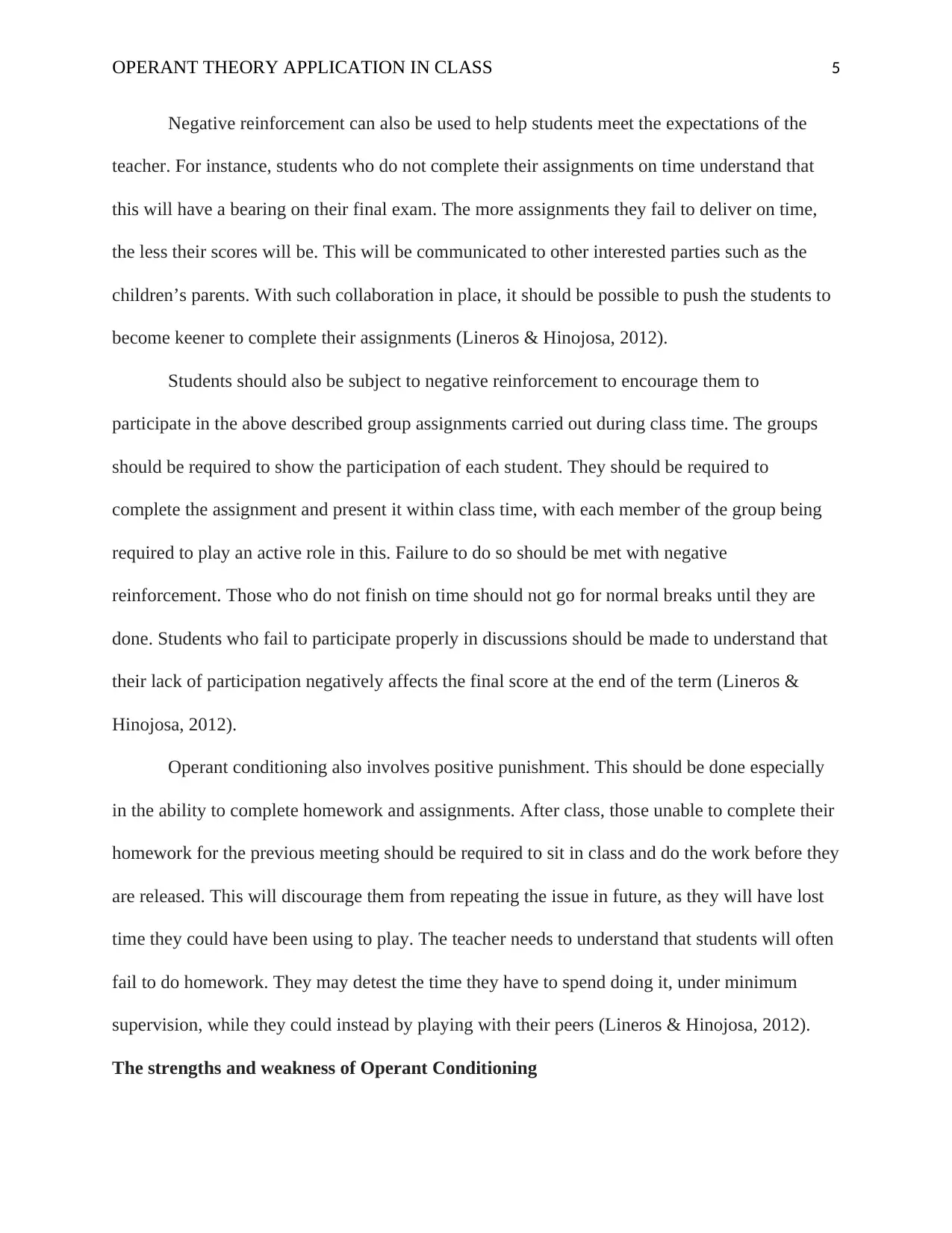
OPERANT THEORY APPLICATION IN CLASS 5
Negative reinforcement can also be used to help students meet the expectations of the
teacher. For instance, students who do not complete their assignments on time understand that
this will have a bearing on their final exam. The more assignments they fail to deliver on time,
the less their scores will be. This will be communicated to other interested parties such as the
children’s parents. With such collaboration in place, it should be possible to push the students to
become keener to complete their assignments (Lineros & Hinojosa, 2012).
Students should also be subject to negative reinforcement to encourage them to
participate in the above described group assignments carried out during class time. The groups
should be required to show the participation of each student. They should be required to
complete the assignment and present it within class time, with each member of the group being
required to play an active role in this. Failure to do so should be met with negative
reinforcement. Those who do not finish on time should not go for normal breaks until they are
done. Students who fail to participate properly in discussions should be made to understand that
their lack of participation negatively affects the final score at the end of the term (Lineros &
Hinojosa, 2012).
Operant conditioning also involves positive punishment. This should be done especially
in the ability to complete homework and assignments. After class, those unable to complete their
homework for the previous meeting should be required to sit in class and do the work before they
are released. This will discourage them from repeating the issue in future, as they will have lost
time they could have been using to play. The teacher needs to understand that students will often
fail to do homework. They may detest the time they have to spend doing it, under minimum
supervision, while they could instead by playing with their peers (Lineros & Hinojosa, 2012).
The strengths and weakness of Operant Conditioning
Negative reinforcement can also be used to help students meet the expectations of the
teacher. For instance, students who do not complete their assignments on time understand that
this will have a bearing on their final exam. The more assignments they fail to deliver on time,
the less their scores will be. This will be communicated to other interested parties such as the
children’s parents. With such collaboration in place, it should be possible to push the students to
become keener to complete their assignments (Lineros & Hinojosa, 2012).
Students should also be subject to negative reinforcement to encourage them to
participate in the above described group assignments carried out during class time. The groups
should be required to show the participation of each student. They should be required to
complete the assignment and present it within class time, with each member of the group being
required to play an active role in this. Failure to do so should be met with negative
reinforcement. Those who do not finish on time should not go for normal breaks until they are
done. Students who fail to participate properly in discussions should be made to understand that
their lack of participation negatively affects the final score at the end of the term (Lineros &
Hinojosa, 2012).
Operant conditioning also involves positive punishment. This should be done especially
in the ability to complete homework and assignments. After class, those unable to complete their
homework for the previous meeting should be required to sit in class and do the work before they
are released. This will discourage them from repeating the issue in future, as they will have lost
time they could have been using to play. The teacher needs to understand that students will often
fail to do homework. They may detest the time they have to spend doing it, under minimum
supervision, while they could instead by playing with their peers (Lineros & Hinojosa, 2012).
The strengths and weakness of Operant Conditioning
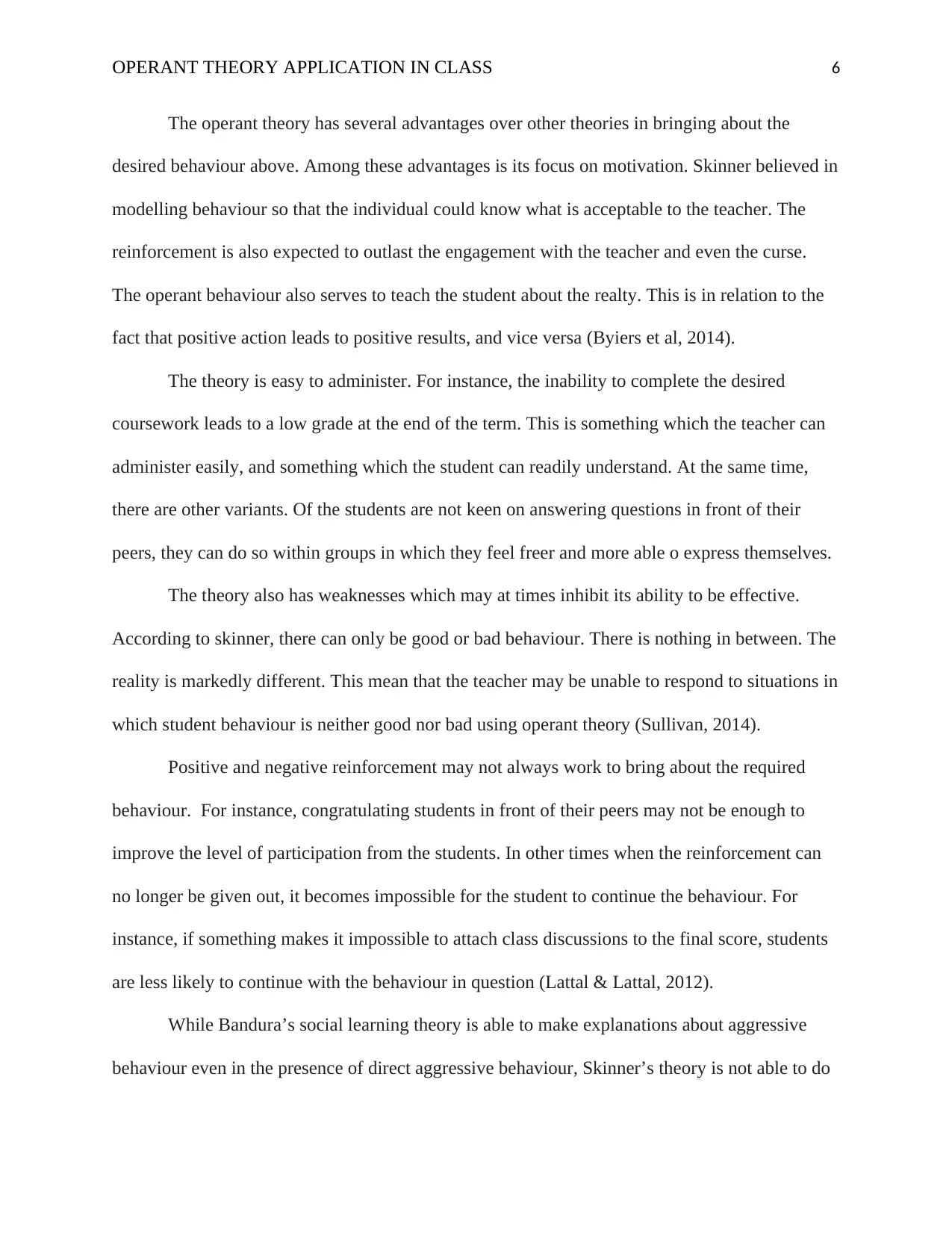
OPERANT THEORY APPLICATION IN CLASS 6
The operant theory has several advantages over other theories in bringing about the
desired behaviour above. Among these advantages is its focus on motivation. Skinner believed in
modelling behaviour so that the individual could know what is acceptable to the teacher. The
reinforcement is also expected to outlast the engagement with the teacher and even the curse.
The operant behaviour also serves to teach the student about the realty. This is in relation to the
fact that positive action leads to positive results, and vice versa (Byiers et al, 2014).
The theory is easy to administer. For instance, the inability to complete the desired
coursework leads to a low grade at the end of the term. This is something which the teacher can
administer easily, and something which the student can readily understand. At the same time,
there are other variants. Of the students are not keen on answering questions in front of their
peers, they can do so within groups in which they feel freer and more able o express themselves.
The theory also has weaknesses which may at times inhibit its ability to be effective.
According to skinner, there can only be good or bad behaviour. There is nothing in between. The
reality is markedly different. This mean that the teacher may be unable to respond to situations in
which student behaviour is neither good nor bad using operant theory (Sullivan, 2014).
Positive and negative reinforcement may not always work to bring about the required
behaviour. For instance, congratulating students in front of their peers may not be enough to
improve the level of participation from the students. In other times when the reinforcement can
no longer be given out, it becomes impossible for the student to continue the behaviour. For
instance, if something makes it impossible to attach class discussions to the final score, students
are less likely to continue with the behaviour in question (Lattal & Lattal, 2012).
While Bandura’s social learning theory is able to make explanations about aggressive
behaviour even in the presence of direct aggressive behaviour, Skinner’s theory is not able to do
The operant theory has several advantages over other theories in bringing about the
desired behaviour above. Among these advantages is its focus on motivation. Skinner believed in
modelling behaviour so that the individual could know what is acceptable to the teacher. The
reinforcement is also expected to outlast the engagement with the teacher and even the curse.
The operant behaviour also serves to teach the student about the realty. This is in relation to the
fact that positive action leads to positive results, and vice versa (Byiers et al, 2014).
The theory is easy to administer. For instance, the inability to complete the desired
coursework leads to a low grade at the end of the term. This is something which the teacher can
administer easily, and something which the student can readily understand. At the same time,
there are other variants. Of the students are not keen on answering questions in front of their
peers, they can do so within groups in which they feel freer and more able o express themselves.
The theory also has weaknesses which may at times inhibit its ability to be effective.
According to skinner, there can only be good or bad behaviour. There is nothing in between. The
reality is markedly different. This mean that the teacher may be unable to respond to situations in
which student behaviour is neither good nor bad using operant theory (Sullivan, 2014).
Positive and negative reinforcement may not always work to bring about the required
behaviour. For instance, congratulating students in front of their peers may not be enough to
improve the level of participation from the students. In other times when the reinforcement can
no longer be given out, it becomes impossible for the student to continue the behaviour. For
instance, if something makes it impossible to attach class discussions to the final score, students
are less likely to continue with the behaviour in question (Lattal & Lattal, 2012).
While Bandura’s social learning theory is able to make explanations about aggressive
behaviour even in the presence of direct aggressive behaviour, Skinner’s theory is not able to do
⊘ This is a preview!⊘
Do you want full access?
Subscribe today to unlock all pages.

Trusted by 1+ million students worldwide
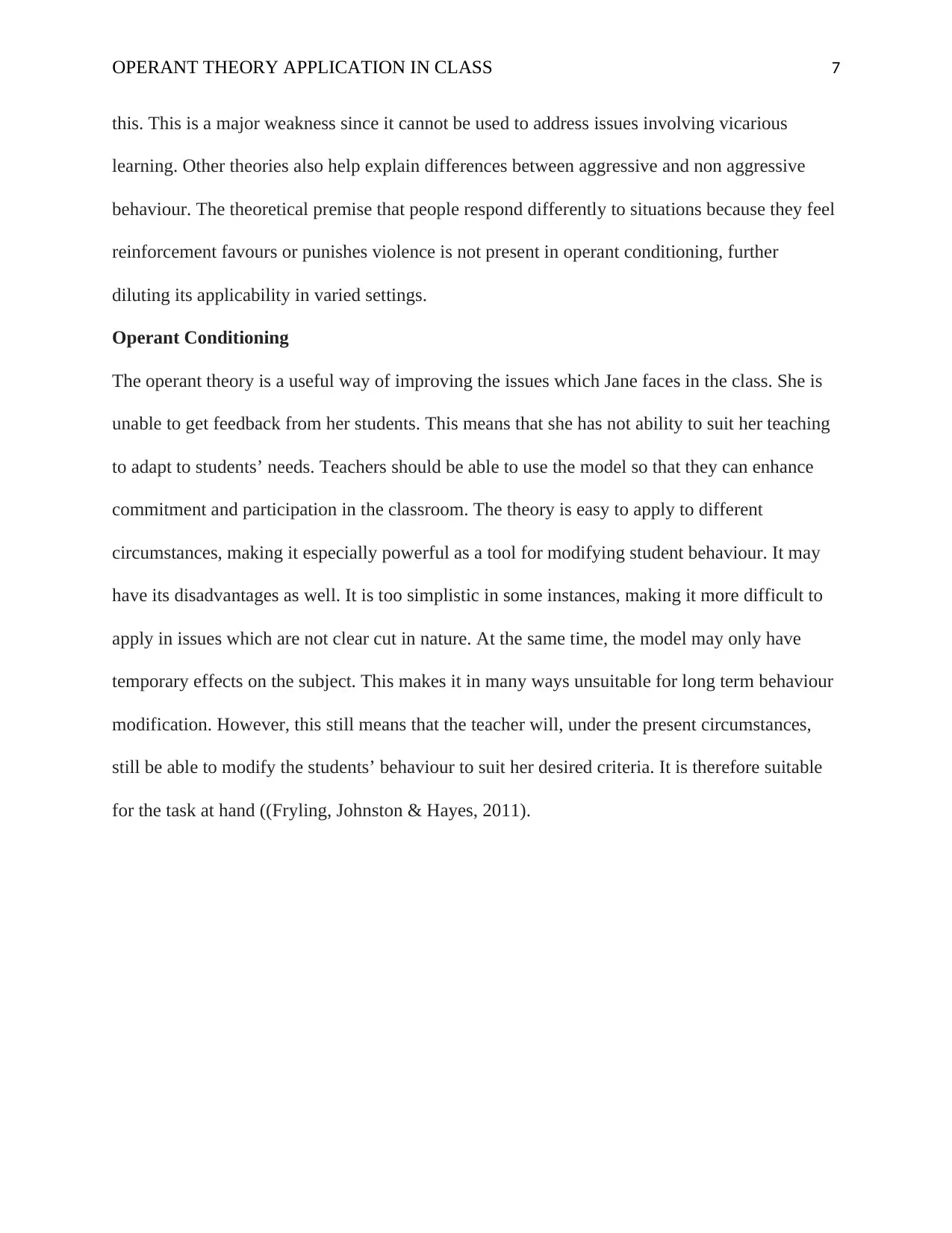
OPERANT THEORY APPLICATION IN CLASS 7
this. This is a major weakness since it cannot be used to address issues involving vicarious
learning. Other theories also help explain differences between aggressive and non aggressive
behaviour. The theoretical premise that people respond differently to situations because they feel
reinforcement favours or punishes violence is not present in operant conditioning, further
diluting its applicability in varied settings.
Operant Conditioning
The operant theory is a useful way of improving the issues which Jane faces in the class. She is
unable to get feedback from her students. This means that she has not ability to suit her teaching
to adapt to students’ needs. Teachers should be able to use the model so that they can enhance
commitment and participation in the classroom. The theory is easy to apply to different
circumstances, making it especially powerful as a tool for modifying student behaviour. It may
have its disadvantages as well. It is too simplistic in some instances, making it more difficult to
apply in issues which are not clear cut in nature. At the same time, the model may only have
temporary effects on the subject. This makes it in many ways unsuitable for long term behaviour
modification. However, this still means that the teacher will, under the present circumstances,
still be able to modify the students’ behaviour to suit her desired criteria. It is therefore suitable
for the task at hand ((Fryling, Johnston & Hayes, 2011).
this. This is a major weakness since it cannot be used to address issues involving vicarious
learning. Other theories also help explain differences between aggressive and non aggressive
behaviour. The theoretical premise that people respond differently to situations because they feel
reinforcement favours or punishes violence is not present in operant conditioning, further
diluting its applicability in varied settings.
Operant Conditioning
The operant theory is a useful way of improving the issues which Jane faces in the class. She is
unable to get feedback from her students. This means that she has not ability to suit her teaching
to adapt to students’ needs. Teachers should be able to use the model so that they can enhance
commitment and participation in the classroom. The theory is easy to apply to different
circumstances, making it especially powerful as a tool for modifying student behaviour. It may
have its disadvantages as well. It is too simplistic in some instances, making it more difficult to
apply in issues which are not clear cut in nature. At the same time, the model may only have
temporary effects on the subject. This makes it in many ways unsuitable for long term behaviour
modification. However, this still means that the teacher will, under the present circumstances,
still be able to modify the students’ behaviour to suit her desired criteria. It is therefore suitable
for the task at hand ((Fryling, Johnston & Hayes, 2011).
Paraphrase This Document
Need a fresh take? Get an instant paraphrase of this document with our AI Paraphraser
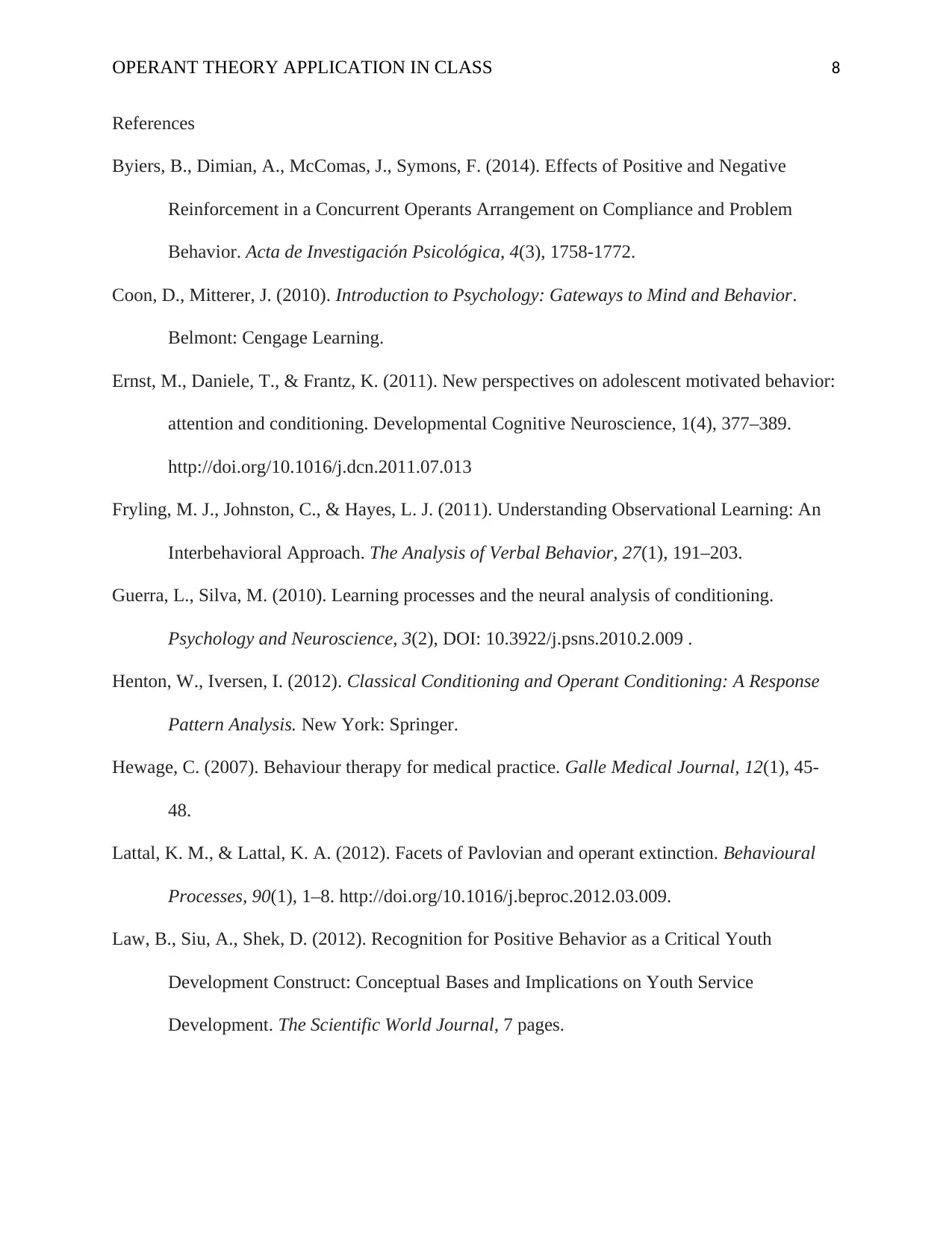
OPERANT THEORY APPLICATION IN CLASS 8
References
Byiers, B., Dimian, A., McComas, J., Symons, F. (2014). Effects of Positive and Negative
Reinforcement in a Concurrent Operants Arrangement on Compliance and Problem
Behavior. Acta de Investigación Psicológica, 4(3), 1758-1772.
Coon, D., Mitterer, J. (2010). Introduction to Psychology: Gateways to Mind and Behavior.
Belmont: Cengage Learning.
Ernst, M., Daniele, T., & Frantz, K. (2011). New perspectives on adolescent motivated behavior:
attention and conditioning. Developmental Cognitive Neuroscience, 1(4), 377–389.
http://doi.org/10.1016/j.dcn.2011.07.013
Fryling, M. J., Johnston, C., & Hayes, L. J. (2011). Understanding Observational Learning: An
Interbehavioral Approach. The Analysis of Verbal Behavior, 27(1), 191–203.
Guerra, L., Silva, M. (2010). Learning processes and the neural analysis of conditioning.
Psychology and Neuroscience, 3(2), DOI: 10.3922/j.psns.2010.2.009 .
Henton, W., Iversen, I. (2012). Classical Conditioning and Operant Conditioning: A Response
Pattern Analysis. New York: Springer.
Hewage, C. (2007). Behaviour therapy for medical practice. Galle Medical Journal, 12(1), 45-
48.
Lattal, K. M., & Lattal, K. A. (2012). Facets of Pavlovian and operant extinction. Behavioural
Processes, 90(1), 1–8. http://doi.org/10.1016/j.beproc.2012.03.009.
Law, B., Siu, A., Shek, D. (2012). Recognition for Positive Behavior as a Critical Youth
Development Construct: Conceptual Bases and Implications on Youth Service
Development. The Scientific World Journal, 7 pages.
References
Byiers, B., Dimian, A., McComas, J., Symons, F. (2014). Effects of Positive and Negative
Reinforcement in a Concurrent Operants Arrangement on Compliance and Problem
Behavior. Acta de Investigación Psicológica, 4(3), 1758-1772.
Coon, D., Mitterer, J. (2010). Introduction to Psychology: Gateways to Mind and Behavior.
Belmont: Cengage Learning.
Ernst, M., Daniele, T., & Frantz, K. (2011). New perspectives on adolescent motivated behavior:
attention and conditioning. Developmental Cognitive Neuroscience, 1(4), 377–389.
http://doi.org/10.1016/j.dcn.2011.07.013
Fryling, M. J., Johnston, C., & Hayes, L. J. (2011). Understanding Observational Learning: An
Interbehavioral Approach. The Analysis of Verbal Behavior, 27(1), 191–203.
Guerra, L., Silva, M. (2010). Learning processes and the neural analysis of conditioning.
Psychology and Neuroscience, 3(2), DOI: 10.3922/j.psns.2010.2.009 .
Henton, W., Iversen, I. (2012). Classical Conditioning and Operant Conditioning: A Response
Pattern Analysis. New York: Springer.
Hewage, C. (2007). Behaviour therapy for medical practice. Galle Medical Journal, 12(1), 45-
48.
Lattal, K. M., & Lattal, K. A. (2012). Facets of Pavlovian and operant extinction. Behavioural
Processes, 90(1), 1–8. http://doi.org/10.1016/j.beproc.2012.03.009.
Law, B., Siu, A., Shek, D. (2012). Recognition for Positive Behavior as a Critical Youth
Development Construct: Conceptual Bases and Implications on Youth Service
Development. The Scientific World Journal, 7 pages.
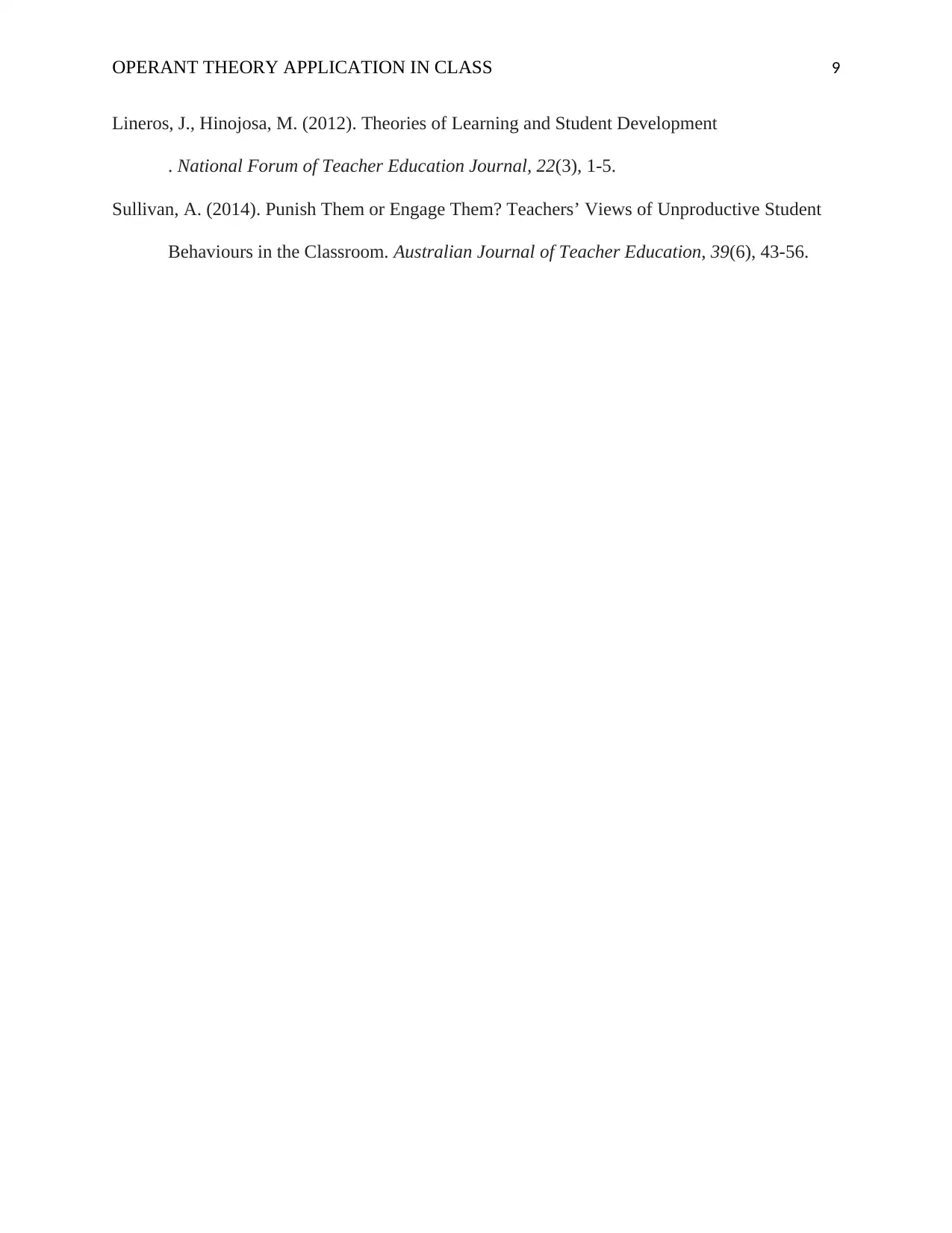
OPERANT THEORY APPLICATION IN CLASS 9
Lineros, J., Hinojosa, M. (2012). Theories of Learning and Student Development
. National Forum of Teacher Education Journal, 22(3), 1-5.
Sullivan, A. (2014). Punish Them or Engage Them? Teachers’ Views of Unproductive Student
Behaviours in the Classroom. Australian Journal of Teacher Education, 39(6), 43-56.
Lineros, J., Hinojosa, M. (2012). Theories of Learning and Student Development
. National Forum of Teacher Education Journal, 22(3), 1-5.
Sullivan, A. (2014). Punish Them or Engage Them? Teachers’ Views of Unproductive Student
Behaviours in the Classroom. Australian Journal of Teacher Education, 39(6), 43-56.
⊘ This is a preview!⊘
Do you want full access?
Subscribe today to unlock all pages.

Trusted by 1+ million students worldwide
1 out of 9
Related Documents
Your All-in-One AI-Powered Toolkit for Academic Success.
+13062052269
info@desklib.com
Available 24*7 on WhatsApp / Email
![[object Object]](/_next/static/media/star-bottom.7253800d.svg)
Unlock your academic potential
Copyright © 2020–2025 A2Z Services. All Rights Reserved. Developed and managed by ZUCOL.





